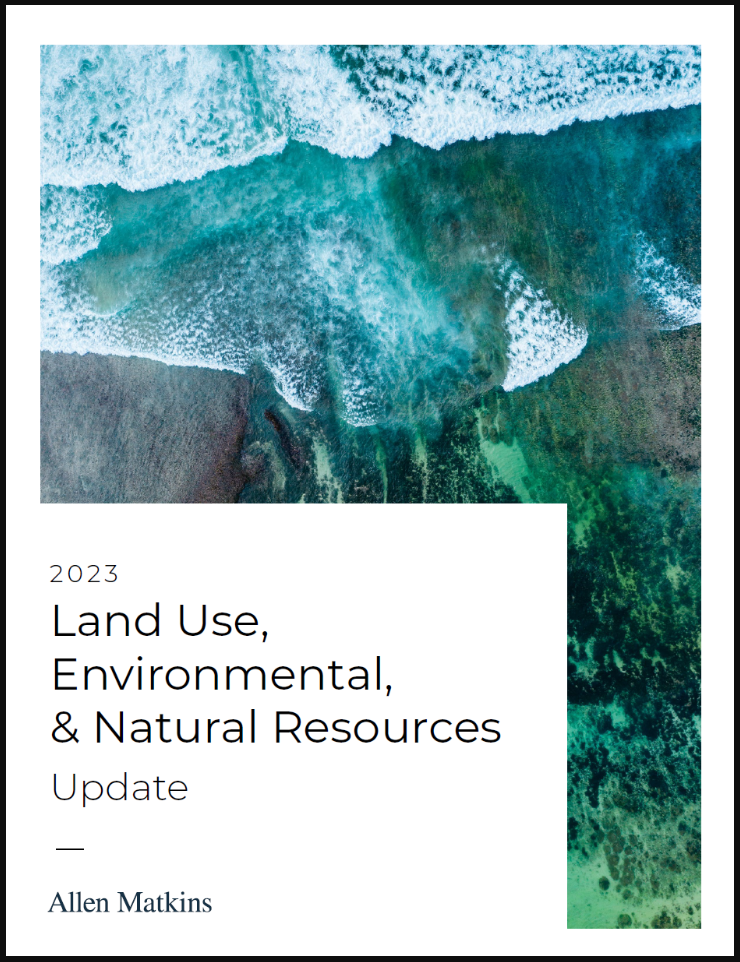News & Insights
2023 Land Use, Environmental, & Natural Resources Update

U.S. EPA and California Move Towards Comprehensive PFAS Regulation
Environmental
5.01.23
In last year’s update, we provided an overview of federal and California regulatory actions designed to protect public health and the environment from the impacts of per- and polyfluoroalkyl substances (PFAS). These actions affected a wide variety of stakeholders within the regulated community, including owners of PFAS-contaminated properties, water purveyors, sellers of products containing PFAS, and industries that utilize PFAS in their operations. Since that update, there have been significant developments, especially at the federal level, where the U.S. Environmental Protection Agency (EPA) has proposed several rules and regulatory actions involving PFAS under the Comprehensive Environmental Response, Compensation, and Liability Act of 1980 (CERCLA), the Clean Water Act (CWA), the Safe Drinking Water Act (SDWA) and the Toxic Substances Control Act of 1976 (TSCA). Some of these developments indicate a shift in the regulatory posture from non-enforceable advisories to more mandatory compliance mechanisms.
Meanwhile, California’s Legislature recently enacted and the Governor signed into law two bills pertaining to PFAS. AB 1817 (Ting) prohibits the manufacture, distribution, or sale within the state of any new textile article containing certain PFAS beginning January 1, 2025. AB 2771 (Friedman) prohibits the manufacture, distribution, or sale of any cosmetic product in the state with “intentionally added” PFAS, also beginning on January 1, 2025.
PFAS Background
PFAS are a large group of synthetic chemical substances that have been used in a variety of commercial, industrial, and military applications for decades. Industries that utilize PFAS in their operations, and are therefore most likely to be affected by PFAS regulation, include oil and gas operations, waste management, metal coating/metal machinery manufacturing, plastics and resins, chemical manufacturing, mining, electronics, printing, and aviation. Common applications include nonstick cookware, water- repellent clothing, stain-resistant fabrics and carpets, cosmetics, firefighting foams, and atoms. Because the carbon-fluorine bond is one of the strongest bonds in chemistry, PFAS do not easily break down in the environment and slowly accumulate in humans, animals, and the environment, earning PFAS the moniker “forever chemicals.” Humans are exposed to PFAS in a variety of ways, including direct contact through occupational exposure or use of PFAS-containing products, ingestion of contaminated drinking water and food, and inhalation of airborne contaminants. EPA has cited scientific research that suggests high levels of exposure to certain PFAS may lead to adverse health effects, including developmental effects and increased risk of some cancers.
Federal Regulation
Proposed CERCLA Regulation
On September 6, 2022, EPA published in the Federal Register a proposed rule to designate two widely used and heavily-studied PFAS compounds – perfluorooctanoic acid (PFOA) and perfluorooctanesulfonic acid (PFOS) – as “hazardous substances” under CERCLA, also known as the Superfund law. CERCLA authorizes the federal government to investigate, remove and remediate releases of hazardous substances to the environment, and it imposes liability for the costs of such activities on “potentially responsible parties” including current owners and operators of sites where the releases occurred, past owners and operators of sites where disposal of hazardous substances occurred, persons who arranged for the disposal of a hazardous substance at a site, and persons who transported a hazardous substance to a site. CERCLA liability is strict – i.e., liability arises without fault – and liability to the government and non-liable private parties is generally joint and several, so that each individual liable party can be held responsible for all of the investigation, removal, and remediation costs.
According to EPA, the designation of PFOA and PFOS as “hazardous substances” will become final in August 2023, though litigation intended to block enforcement of the designation is a strong possibility.
Designating PFOA and PFOS as “hazardous substances” would have far-reaching consequences in California which has approximately 12,000 known PFAS-contaminated sites, second only to Colorado, which has 21,400 sites. Nationwide, it would induce federal, state, and local agencies to require investigation, and potentially, cleanup; cause EPA to designate new Superfund sites; extend the scope of investigation at existing Superfund sites; necessitate the re- opening of closed sites; and expose “potentially responsible parties” to vast liability. Businesses that use PFOA or PFOS would be subject to new reporting rules and regulations. Testing for PFOS and PFOA releases to the environment is likely to become a routine practice in real estate sale and leasing transactions, as is allocating liability risks associated with these compounds. Lenders, in particular, will likely structure loan documents to avoid potential exposure to liabilities arising out of the designation, and environmental insurers, which already often exclude coverage for cleanup costs associated with PFAS compounds, are likely to expand this practice, particularly for PFOS and PFOA.
Addressing PFAS under the Clean Water Act
EPA is also proposing to address PFAS contamination in the nation’s waterways under the Clean Water Act (CWA). On December 5, 2022, EPA announced the availability of Effluent Guidelines Program Plan 15 (Plan 15). Under the CWA, EPA publishes Effluent Limitations Guidelines and Standards (ELGs), which are national wastewater discharge standards applicable to discharges from industrial facilities and developed for specific industries based on the performance of demonstrated wastewater treatment technologies. The CWA requires EPA to periodically review and update ELGs and to biennially publish a plan that establishes a schedule for such revisions.
Plan 15 discusses several actions related to PFAS. First, Plan 15 indicates that EPA intends to initiate a new rulemaking to revise the effluent limitations guidelines for the Landfill Category (40 C.F.R. part 445) due to the presence of PFAS in landfill leachate. Plan 15 also announces EPA’s intention to expand an existing study regarding the use and discharge of PFAS in the Textile Mills Category (40 C.F.R. part 410). Lastly, Plan 15 provides updates on ongoing rulemakings for the Organic Chemicals, Plastics and Synthetics Fibers Category (40 C.F.R. part 414), the Metal Finishing Category (40 C.F.R. part 433), and the Electroplating Category (40 C.F.R. part 413). EPA expects these rules to be finalized by Spring 2024.
Proposed TSCA Regulation
While CERCLA and the CWA address the release or discharge of hazardous substances from industrial facilities, the Toxic Substances Control Act (TSCA) protects public health by authorizing EPA to regulate and screen all chemicals produced or imported into the United States, primarily to ensure the safety of chemicals used in consumer products. On January 26, 2023, EPA published a proposed “significant new use rule” (SNUR) for PFAS that are currently on the TSCA Chemical Substance Inventory but have not been used in manufacturing or processing since 2006. The proposed SNUR would apply to PFAS listed as “Inactive” on the TSCA Inventory.
The proposed SNUR would require any person to notify EPA 90 days in advance before commencing any manufacture (including import) or processing of any of the designated PFAS for a significant new use. EPA must also make a determination that any significant new use does not pose an unreasonable risk of injury to health or the environment, or, if it cannot make that determination, take such regulatory action as necessary. Any person who began manufacturing (including import) or processing of the designated PFAS compounds as a significant new use identified as of January 26, 2023 would have to cease any such activity upon the effective date of the final rule. To resume their activities, these persons would have to first comply with all applicable SNUR notification requirements and wait until all TSCA prerequisites for the commencement of manufacturing (including importing) or processing have been satisfied.
Safe Drinking Water Act
After monitoring the presence of PFAS in public drinking water systems for the past decade, on March 14, 2023, EPA announced the proposed National Primary Drinking Water Regulation (NPDWR) for several PFAS. NPDWRs are legally enforceable primary standards and treatment techniques that apply to public water systems. The pre-publication version of the NPDWR would establish legally enforceable levels (known as maximum contaminant levels or MCLs) for six PFAS in drinking water. The MCLs for PFOA and PFOS – the two most common PFAS – would be set at four parts per trillion (ppt), near the lowest level current laboratory analytical methods can reliably detect the chemicals, with “maximum contaminant level goals” (MCLG) of zero for each. The NPDWR would also regulate four other PFAS chemicals – perfluorononanoic acid (PFNA), hexafluoropropylene oxide dimer acid (HFPO-DA, commonly known as GenX Chemicals), perfluorohexane sulfonic acid (PFHxS), and perfluorobutane sulfonic acid (PFBS) as a group based on their cumulative potential health impacts using a risk-based calculation known as a “Hazard Index” rather than using specific chemical concentrations.
A hazard index is a number calculated to represent the non-cancer health risk of a mixture. The MCL for this group of PFAS chemicals would be set at 1.0 – the level at which non- cancer adverse effects are not likely to occur. This approach is considered more conservative and protective of human health than regulating based on cancer end points and will require water systems to measure the individual chemicals’ chemical concentrations and calculate the cumulative hazard index. The MCLG for these four PFAS would also be set at a Hazard Index of 1.0. The SWDA requires EPA to establish MCLs as close as feasible to the MCLG for a chemical, taking into account treatment costs, and to publish a health risk reduction and cost analysis for each contaminant to be regulated under the NPDWR. EPA must also make a determination whether or not the benefits of the regulation outweigh the compliance costs. EPA now has 18 months to promulgate a final rule, although EPA has stated that it intends to finalize its PFOA and PFOS NPDWR regulations by Fall 2023.
California Legislation
At the state level, Governor Newsom recently signed into law AB 1817 and AB 2771, which prohibit the manufacture, distribution, and sale of certain “textile articles” containing PFAS and cosmetic products containing intentionally added PFAS, respectively. Both bills take effect on January 1, 2025.
AB 1817 prohibits any person from manufacturing, distributing, selling, or offering for sale in the state a new textile article that contains regulated PFAS. AB 1817 defines regulated PFAS to mean PFAS 12 that a manufacturer has intentionally added for a functional or technical effect or PFAS that exceeds a certain threshold. Commencing on January 1, 2025, the threshold is 100 parts per million (“ppm”) and decreases to 50 ppm on January 1, 2027. AB 1817 also applies to a wide variety of products, as the bill defines “Textile Articles” as “Apparel,” i.e., clothing intended for regular wear or formal occasions, outdoor apparel, handbags, and backpacks. AB 1817 also applies to household items such as shower curtains, bedding, towels, and tablecloths. AB 1817 would require manufacturers to provide to distributors and sellers a certificate of compliance that the textile article is free from regulated PFAS.
AB 2771 prohibits any person or entity from manufacturing, selling, delivering, holding, or offering for sale in commerce any cosmetic product that contains intentionally added PFAS. AB 2771 defines “intentionally added” to mean either (1) PFAS chemicals that a manufacturer has intentionally added to a product and that have a functional or technical effect on the product or (2) PFAS chemicals that are “intentional breakdown products” of an added chemical. AB 2771 also defines “cosmetic product” to mean an article for retail sale or professional use intended to be rubbed, poured, sprinkled, or sprayed on, introduced into, or otherwise applied to the human body for cleansing, beautifying, promoting attractiveness, or altering appearance. Manufacturers of textile articles and entities in the supply chain for cosmetics should take advantage of the available time before the January 1, 2025 effective date to implement compliance strategies for AB 1817 and AB 2771.
Conclusion
Taken together, these regulatory actions are further evidence that federal and state agencies are continuing to build a comprehensive regulatory scheme to address PFAS in the economy and in the environment. A broad and diverse group of stakeholders will be impacted and should remain abreast of developments that will affect their business or operations. For assistance in understanding any of the regulatory developments described above and how they may impact your business or industry, please feel free to contact Allen Matkins’ Land Use, Environmental & Natural Resources Practice Group.
Authors
Partner
Associate
RELATED SERVICES
Allen Matkins Leck Gamble Mallory & Natsis LLP. All Rights Reserved.
This publication is made available by Allen Matkins Leck Gamble Mallory & Natsis LLP for educational purposes only to convey general information and a general understanding of the law, not to provide specific legal advice. By using this website you acknowledge there is no attorney client relationship between you and Allen Matkins Leck Gamble Mallory & Natsis LLP. This publication should not be used as a substitute for competent legal advice from a licensed professional attorney applied to your circumstances. Attorney advertising. Prior results do not guarantee a similar outcome. Full Disclaimer



